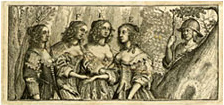Roland Fréart, A Parallel of the Ancient Architecture with the Modern (1664)
Full Text
Not available
EEBO/TCP
Not available
Date
1664
Author
Translator
John Evelyn Note: 30/09/2005
Lexicon title
An Account Of Architects & Architecture, Together With An Historical, and Etymological Explanation of certain Tearms particularly affected by Architects
Book title
A Parallel Of The Antient Architecture With The Modern, In a Collection of Ten Principal Authors who have written upon the Five Orders, Viz. Palladio and Scamozzi, Serlio and Vignola, D. Barbaro and Cataneo, L. B. Alberti and Viola, * Bullant and De Lorme, Compared with one another. The three Greek Orders, Dorique, Ionique, and Corinthian, comprise the First Part of this Treatise. And the two Latine, Tuscan and Composita the Latter. Written in French by Roland Freart, Sieur de Chambray; Made English for the Benefit of Builders. To which is added an Account of Architects and Architecture, in an Historical, and Etymological Explanation of certain Tearms particularly affected by Architects. With Leon Baptista Alberti's Treatise of Statves
Publication place
London
Printer
Thomas Roycroft
Publisher
John Place
Transcription source
EEBO/TCP
Text type
printed book
Genre
Treatises
Subject area
architecture
Summary
Sizable paragraphs devoting to explaining hard words in architecture.
Language
headwords: English
explanations: English
explanations: English
explanations: English
explanations: English
Extent
115-42
Word-group
type: alphabetical
Word-entry
type: headword
sample: The Astragal, which besides divers other things (as the Stem spinae Vertebrae neer the neck) has here its analogy from that done a little above the Heel, whence the French name it the Talon or Heel it selfe (as our Author of the Parallel) nor improperly; but by the Italians il Tondino being a kind of halfe Torus, sometimes wrought in the richer Orders like an over-cast hem or edg to the larger Tore, which frequently is plac'd between, as in the Ionick Base with two Scotias, and sometimes (though rarely) just about the Plinth of the Base, as some marshal it: Otherwhiles again it is taken for the Cincture or Coller next the Hypotrachelium and diminution of a Column listed on both edges; and it runs also under the Echinus of the Ionick. Our Englisher of Hans BloomeBoltell, of Fillet in any part of a Pillar, but I take a Fillet to be more flat, this more swelling and (as I say) Torus-like. Moreover we sometimes find it dividing the Fascia of the Corinthian Architrave where it is wrought in Chapletts and Bends or Berries: and finally in two places, both above and beneath the Lists joyning immediately to the Square or Die of a Pedistal where Stylobata is introduced; and so we have done with the ornaments and mouldings of the Base. (p. 75)
sample: The Astragal, which besides divers other things (as the Stem spinae Vertebrae neer the neck) has here its analogy from that done a little above the Heel, whence the French name it the Talon or Heel it selfe (as our Author of the Parallel) nor improperly; but by the Italians il Tondino being a kind of halfe Torus, sometimes wrought in the richer Orders like an over-cast hem or edg to the larger Tore, which frequently is plac'd between, as in the Ionick Base with two Scotias, and sometimes (though rarely) just about the Plinth of the Base, as some marshal it: Otherwhiles again it is taken for the Cincture or Coller next the Hypotrachelium and diminution of a Column listed on both edges; and it runs also under the Echinus of the Ionick. Our Englisher of Hans BloomeBoltell, of Fillet in any part of a Pillar, but I take a Fillet to be more flat, this more swelling and (as I say) Torus-like. Moreover we sometimes find it dividing the Fascia of the Corinthian Architrave where it is wrought in Chapletts and Bends or Berries: and finally in two places, both above and beneath the Lists joyning immediately to the Square or Die of a Pedistal where Stylobata is introduced; and so we have done with the ornaments and mouldings of the Base. (p. 75)
Alston
XVIII.II.327
Wing
C1923
Other editions
1680: Wing C1924; Alston XVIII.II.328




